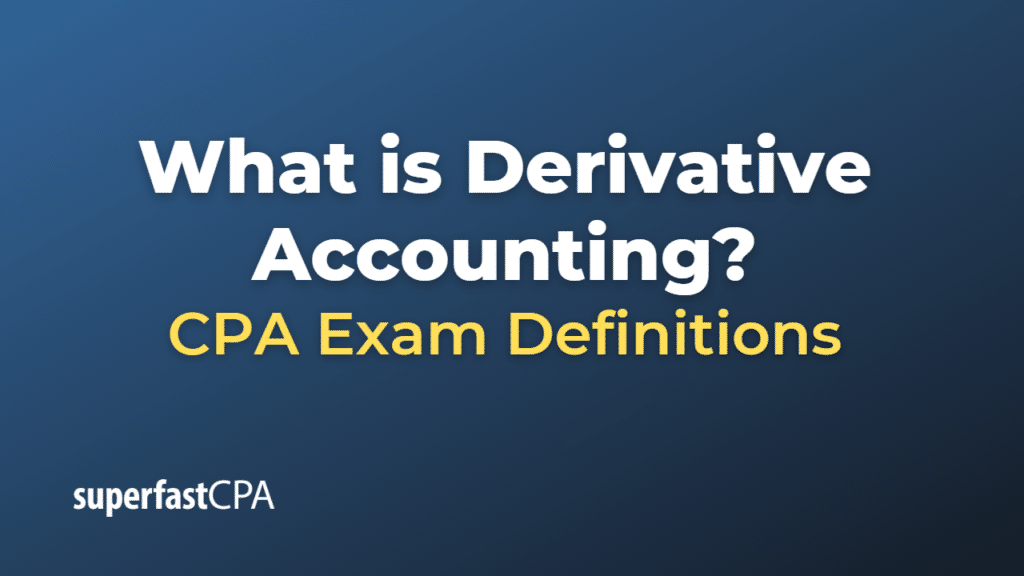Derivative Accounting
Derivative accounting refers to the rules and practices involved in recording derivatives on a company’s financial statements. Given that derivatives can have significant impacts on a company’s financial position, these rules are crucial to ensuring accurate and transparent reporting.
The accounting for derivatives can be quite complex due to their inherent characteristics. For example, a derivative’s value can fluctuate significantly over time as the value of the underlying asset changes. Additionally, derivatives are often used for hedging, which adds another layer of complexity to their accounting treatment.
In the United States, the Financial Accounting Standards Board (FASB) issued Statement No. 133, “Accounting for Derivative Instruments and Hedging Activities,” which was later incorporated into the Accounting Standards Codification (ASC) as Topic 815. This statement sets forth the standards for derivative accounting, including when and how derivatives should be recorded, measured, and disclosed on a company’s financial statements.
According to ASC 815, all derivatives should be recorded on the balance sheet at fair value. Changes in the fair value of derivatives are recognized in earnings unless specific hedge accounting criteria are met.
If a derivative is designated as a hedge, the accounting treatment differs based on the type of hedging relationship:
- Fair Value Hedge: If a derivative is used to hedge against changes in the fair value of a recognized asset or liability or an unrecognized firm commitment, any gain or loss on the derivative, as well as the offsetting loss or gain on the hedged item attributable to the hedged risk, is recognized in current earnings.
- Cash Flow Hedge: If a derivative is used to hedge against the variability of cash flows related to a recognized asset or liability or a forecasted transaction, the effective portion of the derivative’s gain or loss is initially reported as a component of other comprehensive income (outside earnings) and is reclassified into earnings when the forecasted transaction affects earnings. The ineffective portion is immediately recognized in earnings.
- Net Investment Hedge: If a derivative is used to hedge against the foreign currency exposure of a net investment in a foreign operation, the gain or loss on the derivative is reported in other comprehensive income to the extent it is effective, offsetting the translation gain or loss on the net investment in the foreign operation.
The rules are quite complex and often require judgment in their application. For this reason, derivative accounting can be a challenging area for companies that use derivatives for hedging or other purposes.
Example of Derivative Accounting
Here’s a simplified example illustrating how derivative accounting can work, specifically with a fair value hedge.
Let’s say a company, Company ABC, has a $1 million investment in bonds issued by another company, XYZ Corp. The bonds are sensitive to interest rate fluctuations, and ABC is concerned about the potential for interest rates to rise, which would decrease the fair value of their bond investment.
To hedge this risk, ABC enters into an interest rate swap contract (a type of derivative), where they agree to exchange a variable interest rate for a fixed rate. The terms of the swap are such that if interest rates increase, the fair value of the swap will increase by an amount that should offset the decrease in the fair value of the bonds.
Now, let’s say that over the next accounting period, interest rates do indeed rise. As a result, the fair value of ABC’s bond investment decreases by $50,000. Simultaneously, due to the increased interest rates, the fair value of the swap contract increases by $50,000.
In their accounting, ABC would:
- Record a loss of $50,000 in its income statement for the decrease in fair value of the bonds. This would be recorded as a loss from fair value adjustment or something similar.
- Record a gain of $50,000 in its income statement for the increase in the fair value of the swap. This would be recorded as a gain from fair value adjustment or similar.
The net effect on ABC’s income statement would be zero, demonstrating that the derivative effectively hedged the interest rate risk of the bond investment.
This is a simple example and actual fair value hedge accounting can involve more complexity. Also, the company would have to meet several criteria, including documentation and effectiveness assessment requirements, to apply this hedge accounting treatment under the accounting standards.













